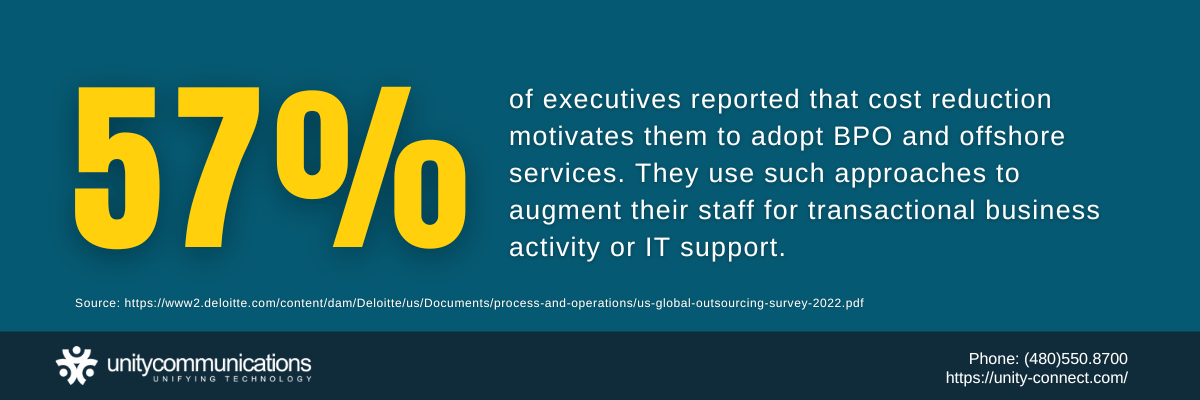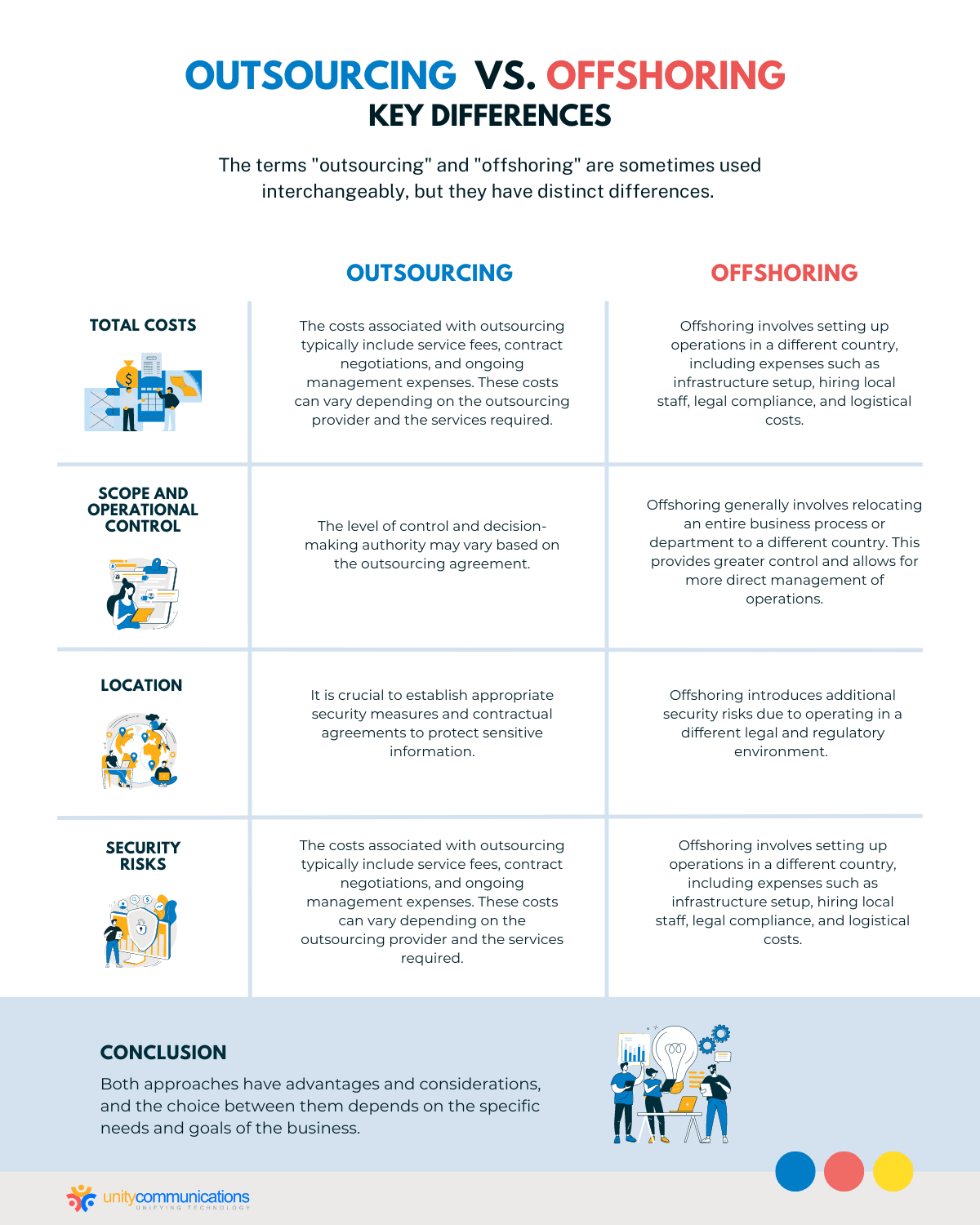Table of Contents
Backlogs slow progress on project completion or service delivery. As such, non-core functions can overshadow and steal resources from your growth-driven initiatives, delaying the time-to-market of your products and services.
Many enterprises turn to business process outsourcing (BPO) to address such issues. Some companies outsource a specific business function, while others choose to offshore some of their processes.
But is there a difference? Should you outsource or offshore?
This article explores how different outsourcing and offshoring are to help you make a wise decision for your business. It also discusses best practices when adopting either approach.
Outsourcing vs. Offshoring: An Overview

Working with a third-party service provider comes to mind when someone asks what BPO is. Outsourcing occurs when companies want to prioritize improving their core business offerings while cutting operating expenses.
A U.S.-based company, for instance, hires a service provider in another state (onshore outsourcing), a neighboring country (nearshore outsourcing), or an overseas country such as the Philippines (offshore outsourcing). It does so to quickly and effectively perform these front- and back-office tasks.
- Customer service
- Information technology (IT) support
- Finance and accounting
- Healthcare support
- E-commerce support
- Human resources (HR) services
- Sales and digital marketing
- Cloud services
- Manufacturing and inventory management
- Knowledge and legal processing
Due to increased cost savings and productivity, the global outsourcing market constantly grows. In 2022 alone, the industry reached a market value of almost $262 billion, according to Grand View Research’s latest data. The organization expects the sector to expand at a compound annual growth rate (CAGR) of 9.4% from 2023 to 2030.
Despite such benefits, businesses might lose touch with their product quality when acquiring BPO services. Entrusting a function to an external party might also lead to job losses for some in-house staff members. This gap happens when companies find third-party contractors more efficient and capable of accomplishing tasks at their desired speed.
Businesses aiming to maximize the benefits of an offshore workforce while expanding their in-house talent can try offshoring. It refers to relocating or establishing a subsidiary in another country, specifically in developing nations with a low-cost labor pool. Companies typically offshore customer support, manufacturing, and software development.
Offshoring lets companies boost global competitiveness by accessing new markets, optimizing diverse talent, and enabling scalable business operations. But this business strategy comes with risks that include:
- Navigating various legal and cultural environments
- Dealing with language barriers
- Encountering quality control issues
- Ensuring intellectual property protection
- Upholding ethical labor practices and social responsibilities
- Facing different data security threats
Key Differences Between Outsourcing and Offshoring

Because people still get confused about “outsourcing” and “offshoring,” knowing their differences is crucial. You must know how distinct they are for better budget and business development planning.
Such clarifications further allow you to truly understand the BPO challenges and appreciate the BPO advantages. As you decide whether to outsource or offshore your non-core functions, remember these major distinctions between hiring a service provider and establishing a unit overseas.
Outsourcing vs. Offshoring: Total Costs
Both outsourcing and offshoring let you save money on non-revenue-generating processes. The difference lies in which resources you can cut from the total operating costs and by how much. See the table below for a more straightforward comparison.
| Expense | Outsourcing | Offshoring |
|---|---|---|
| Since providers already have the necessary resources, you: | Because you set up a unit overseas, you: | |
| Labor |
|
|
| Technology |
|
|
| Real estate and utilities |
|
|
Based on Deloitte’s latest statistics, 57% of executives reported that cost reduction motivates them to adopt BPO and offshore services. They use such approaches to augment their staff for transactional business activity or IT support.
Gaining cost savings remains dependent on your business decisions, though. Select outsourcing if you want temporary support for weeks or months. Otherwise, offshoring is your best bet for a long-term, cost-effective business unit outside your home country.
Outsourcing vs. Offshoring: Scope and Operational Control
BPO service providers employ cutting-edge automated solutions to manage a wide array of front- and back-office processes. Their efficiency and precision free up your in-house team to concentrate on core functions.
In contrast, your offshore team members handle tasks akin to those performed by your domestic staff. For example, if you own a beverage factory and decide to relocate manufacturing operations to the Philippines, Filipino workers follow the same procedures and strategies as your American counterparts, albeit with lower labor costs.
Should you aim to retain comprehensive operational control while reducing expenses, opting for offshoring is the solution. It permits you to oversee and maintain the same level of quality in your onshore business operations, provided you select the right personnel.
Outsourcing vs. Offshoring: Location
Outsourcing offers the flexibility to choose service providers from within your own country, neighboring nations, or even global destinations. Offshoring, on the other hand, allows you to shift operations to foreign countries characterized by a lower cost of living, such as the Philippines or India.
If your priority is synchronized business hours and minimal cultural differences, outsourcing non-core tasks to U.S.-based firms or neighboring countries like Canada and Mexico may be the optimal choice. However, if your objective is to provide 24/7 support and expand your market presence while managing costs effectively, offshoring becomes a compelling option.
Outsourcing vs. Offshoring: Security Risks
Both outsourcing and offshoring pose risks to your sensitive business and customer data. Because information sharing occurs online, your data becomes vulnerable to cyber threats such as breaches and hacks.
According to the 2022 Internet Crime Report from the FBI’s Internet Crime Complaint Center, phishing and personal data breaches are among the top incidents filed. In Illinois alone, victims lose an average of over $30 million due to technical support scams.
If you do not work closely with your third-party and offshore teams, expect to receive the same complaints or lose the same amount of money. Thus, you must carefully align your security measures and policies to strengthen your data protection.
Best Practices for Outsourcing and Offshoring

Whether you opt for outsourcing or offshoring, a well-thought-out plan is essential to guarantee returns and preempt potential conflicts. Consider these best practices when in the process of selecting a service provider or contemplating the establishment of a new overseas branch.
- Identify in-house challenges. Recognize the areas within your organization that impede productivity and require immediate attention. It also aids in pinpointing non-core functions that consume resources without yielding positive outcomes.
- Clarify your business goals.Having well-defined, measurable objectives is instrumental in making informed decisions. This practice enables you to allocate resources effectively and ensure cost-efficiency.
- Perform market research. Delving into the outsourcing and offshoring landscape provides valuable insights into how these strategies can benefit and impact your business. This research offers an understanding of the prerequisites, emerging trends, and essential resources to consider before venturing into BPO or establishing an overseas subsidiary.
- Conduct a cost analysis. An in-depth cost analysis is imperative to determine whether outsourcing and offshoring align with your financial requirements. This analysis also quantifies potential cost savings associated with engaging a service provider or setting up operations in another country.
- Finalize investment decisions.Once you’ve compiled a comprehensive list of challenges, needs, requirements, and potential budget allocations, it’s time to make a well-informed choice between outsourcing and offshoring. Seek input and guidance from board members, executives, investors, and legal advisors to ensure a judicious business decision.
The Bottom Line

Outsourcing and offshoring are two simple but distinct terms. If you do not understand the difference between these concepts, you might overspend instead of saving on costs when adopting BPO or establishing a new branch overseas.
Although these approaches bring you significant cost reductions, your total savings depend on several factors such as labor, equipment, and the workplace. When deciding whether to outsource or offshore, consider location, scope, operational control, security risks, and best practices.
Let’s connect once you are prepared to try BPO. We have scalable teams in our onshore, nearshore, and offshore locations ready to assist your business growth.




